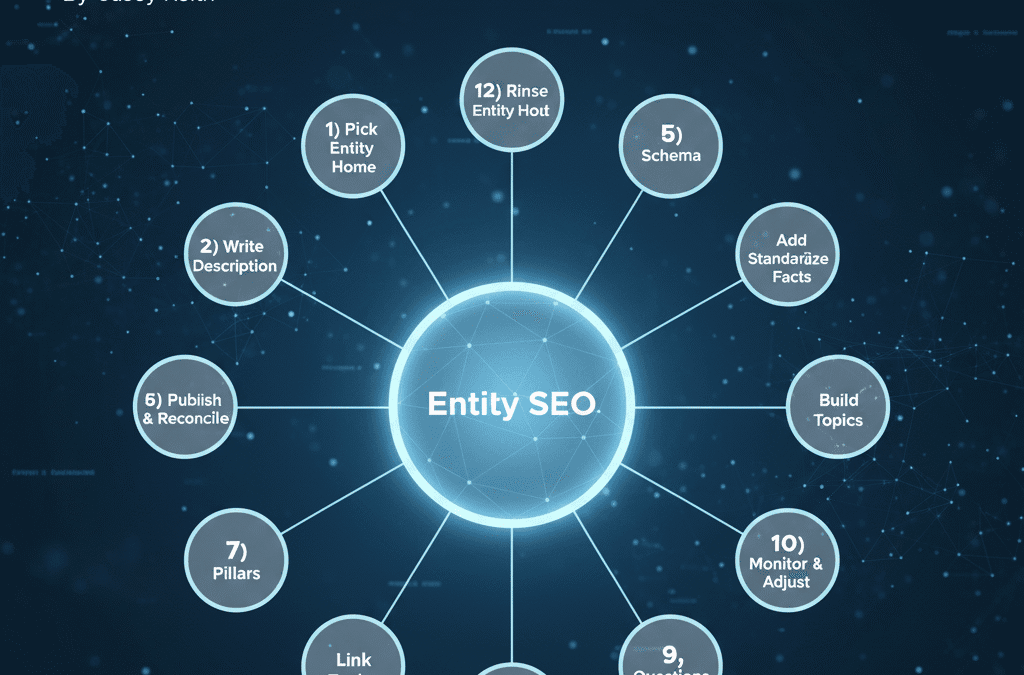1) Pick the Entity Home
Do it: Choose one page as the official home for each main thing, like brand, key people, and products.
Why it matters: Google needs a single source of truth.
Pro tip: Keep the URL stable and boring. Fancy is fragile.
2) Write the Clear Description
Do it: In the first 100–150 words, answer who or what it is, what it does, and who it is for.
Why it matters: If a smart 12-year-old can get it, Google can, too.
Pro tip: Dates, locations, versions, and specs count as facts. Facts travel well.
3) Add Schema That Mirrors the Page
Do it: Add structured data that repeats the same facts. Use the right type, like Organization, Person, Product, WebPage, Article.
Why it matters: You are handing Google the study notes in its own language.
Pro tip: Include mainEntityOfPage on the entity, about and mentions on content pages, and sameAs links to authoritative profiles you control.
4) Standardize Your Facts Everywhere
Do it: Make your name, description, logo, founders, dates, and key attributes match across profiles and directories you actually manage.
Why it matters: Consistency raises confidence. Inconsistency makes Google guess, and guesswork costs you.
Pro tip: Keep a one-page fact sheet everyone uses. I learned that the hard way. I got a few regrets.
5) Map Your Topics and Supporting Entities
Do it: For each pillar topic, list 5–10 closely related entities that a solid page would reasonably mention.
Why it matters: Context signals what you really mean.
Pro tip: If two terms do the same job in context, pick one and move on. You are not paid by the synonym.
6) Build Pillars and Clusters
Do it: Create a strong pillar page for the main topic, then supporting pages for subtopics.
Why it matters: You are showing depth, not just dropping buzzwords.
Pro tip: Each page should be primarily about one thing. One page, one hero.
7) Link Internally With Purpose
Do it: Link subtopics to the pillar and cross-link siblings when it helps the reader.
Why it matters: Links are how Google sees relationships.
Pro tip: Use natural anchors that name the thing, not “click here.” Obvious, but here we are.
8) Cover Questions People Actually Ask
Do it: Add short Q&A sections that address who, what, when, where, why, how.
Why it matters: Questions expose intent, intent drives matches.
Pro tip: If you can answer it in one tight paragraph, do it. Save the novels for later.
9) Add Helpful Media and Label It
Do it: Use clear images, charts, or tables, then write sensible alt text and captions.
Why it matters: Extra context, more “grip” for understanding.
Pro tip: File names that say what the image is, not “IMG_9273.” Obviously.
10) Publish, Then Reconcile
Do it: After publishing, update your profiles so the facts match your Entity Home.
Why it matters: Corroboration kicks in only when the web reflects your page.
Pro tip: Prioritize profiles and directories that rank for your name and products.
11) Monitor and Adjust
Do it: Check what shows when you search your brand and key products. Track new queries you start earning.
Why it matters: If the results look like your business card, you are on track.
Pro tip: Review quarterly. Fix stale facts fast. When your grocery bill looks like a car payment, you want your SEO working, not drifting.
12) Rinse, Then Go Deeper
Do it: Expand to the next set of supporting entities and questions.
Why it matters: Authority compounds.
Pro tip: Depth beats breadth until the pillar actually feels complete.
Quick Starter Template
Use this for any page you want Google to truly “get.”
- Primary entity:
- One-sentence definition:
- Who it is for:
- Top 5 supporting entities to mention:
- 3 user questions to answer:
- Internal links to add:
- Schema type and key properties:
- External profiles to align:
Common Mistakes To Avoid
- Spreading one entity across three half-pages. Pick a home.
- Schema that says things the page does not say. That is how you confuse machines.
- Keyword counting instead of context building.
- Generic internal anchors. Name the thing.
- Letting old facts linger. Clean your trail.
All right, that is the playbook. Not fancy, just solid. Do this, and you stop yelling keywords at the void and start getting matched to the people who actually want what you do.

